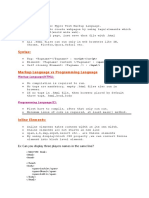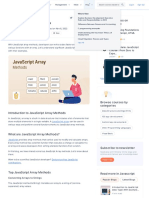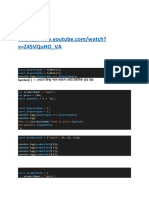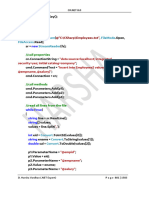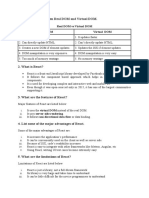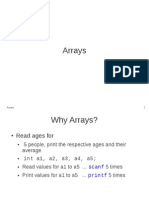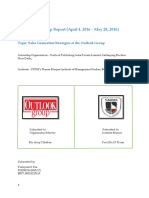React Sample Programs
Uploaded by
Amrit RanabhatReact Sample Programs
Uploaded by
Amrit RanabhatSample Programs-React
React -Example Programs
Program to create multiple Class components
App.js
import './App.css';
import React from 'react';
class First extends React.Component {
render() {
return (
<div class="App">
<h1>Dr. AIT</h1>
<h3>IDE</h3>
</div>
);
}
}
class Second extends React.Component {
render() {
return (
<div class="App1">
<h2>MCA Department</h2>
</div>
);
}
}
class App extends React.Component {
render() {
return (
<div>
<First/>
<Second/>
</div>
);
}
}
export default App;
1. /*****---Class Component ********/
App.js
class App extends Component{
render(){
return(<>
<table>
<tr>
<th>Name</th>
<th>Age</th>
</tr>
<tr>
<td>Sudha</td>
<td>21</td>
SHOBHA RANI, DR. AIT 1
Sample Programs-React
</tr>
<tr>
<td>Nikhil</td>
<td>32</td>
</tr>
</table>
</>
);
}
}
export default App;
Example-
2. /*****---Class Component with files********/
Program to create a multiple child components in different files
App.js
import './App.css';
import React,{Component} from 'react';
import Welcome from './components/Welcome.js';
import Dept from './components/Dept.js';
import Tabl from './components/Tabl.js';
class App extends Component{
render(){
return(<>
<Welcome />
<Dept />
<Tabl />
</>
);
}
}
export default App;
Welcome.js
class Welcome extends Component{
render(){
return <>
<h2>Hello Students</h2>
<p> Welcome to Full stack Web development</p>
</>;
}
}
export default Welcome;
SHOBHA RANI, DR. AIT 2
Sample Programs-React
Dept.js
function Dept() {
return <h2>Hi, I am from MCA!</h2>;
}
export default Dept;
Tabl.js
class Tabl extends React.Component{
render(){
return (
<table>
<tr style={{"borderWidth":"1px", 'borderColor':"#aaaaaa",
'borderStyle':'solid'}}>
<th>Name</th>
<th>Age</th>
</tr>
<tr>
<td>Sudha</td>
<td>21</td>
</tr>
<tr>
<td>Nikhil</td>
<td>32</td>
</tr>
</table>
);
}
}
export default Tabl;
3. /********** --COMPONENT with props---******** */
Program to create a component using Properties(props) with files
App.js
import React from 'react';
import Branch from './components/Branch.js';
class App extends React.Component {
render() {
return (
<div>
<Branch name = "Computer Science" />
<Branch name = "Information Science" />
</div>
);
}
}
export default App;
SHOBHA RANI, DR. AIT 3
Sample Programs-React
Branch.js
const Branch = (props) => {
return < h1 > {props.name} </ h1>
}
export default Branch;
1. /********** --COMPONENT with props---Ex-1******** */
Program to create a component using Properties(props) in parent component
import React, { Component } from 'react';
class App extends Component {
render() {
return (
<div >
<Person code="20MCAE02" name="R Programming" sem="6"></Person>
<Person code="20MCAE03" name="Full Stack" sem="5" ></Person>
</div>
);
}
}
class Person extends Component {
render() {
return (
<>
<ul>
<li> IDE Subjects</li>
<ol>
<li> Subject code: {this.props.code} </li>
<li> Subject Name: {this.props.name}</li>
<li> Semester : {this.props.sem} </li>
</ol> </ul>
</>
)
}
}
export default App;
OUTPUT:
SHOBHA RANI, DR. AIT 4
Sample Programs-React
2. /********** --COMPONENT with state---Ex-1******** */
Program to create a component with state
import React from 'react';
class Subject extends React.Component {
constructor(props) {
//to implement the constructor for a React component,
//call the super(props) method before any other statement.
super(props);
//super(props) would pass props to the parent constructor.
this.state = {
dep: "MCA",
sub: "Data Science"
};
}
changeIDE = () => {
this.setState({sub: "Full Stack"});
}
render() {
return (
<div>
<h2>Department is {this.state.dep}</h2>
<p style={{color: "red"}}>
My IDE is {this.state.sub}
</p>
<button type="button" onClick={this.changeIDE}>Change IDE</button>
</div>
);
}
}
export default Subject;
OUTPUT:
SHOBHA RANI, DR. AIT 5
Sample Programs-React
3. /*****---Component with State –Ex-2********/
Program to implement state for BUTTONS
import React,{useState} from 'react';
import image from './college.jpg';
function App(){
const [show,setShow]=useState()
return(
<div ClassName="App">
{
show?<img src={image} alt="check" height={200} width={400} />:null
}
<br />
<button onClick={()=>setShow(true)}> Show</button>
<button onClick={()=>setShow(false)}> Hide</button>
</div>
)
}
export default App;
OUTPUT:
SHOBHA RANI, DR. AIT 6
Sample Programs-React
4. /*****---Component with State –Ex-3********/
Program to implement state for a BUTTON (as Toggle state)
import React,{useState} from 'react';
import image from './college.jpg';
function App(){
const [show,setShow]=useState()
return(
<div ClassName="App">
{
show?<img src={image} alt="check" height={100} width={300} />:null
}
<br />
<button onClick={()=>setShow(!show)}> Toggle</button>
</div>
)
}
export default App;
Notice that we are setting the show as ‘not show’. Initially, the show is true. On clicking the button, it
will become false. On clicking again, it will become true. This will go on and the value of the show will
be inverted with each click.
OUTPUT:
SHOBHA RANI, DR. AIT 7
Sample Programs-React
5. /*****---Component with State –Ex-3********/
Program to implement state by getting value from a textbox
function App() {
const[data,setData]=useState(null)
function getData(val)
{
setData(val.target.value)
console.warn(val.target.value)
}
return(
<div className="App">
<h1>{data}</h1>
<input type="text" onChange={getData} />
</div>
);
}
export default App;
OUTPUT:
Program to implement Form Validations
App.js
import './App.css';
import Login from './eventhandle/Login.js';
function App() {
return (
<div className="App">
<Login />
</div>
);
}
export default App;
Login.js
import React,{useState} from 'react';
function Login() {
const[user,setUser]=useState("")
SHOBHA RANI, DR. AIT 8
Sample Programs-React
const[userErr,setUserErr]=useState(false)
function userhandle(e){
let item=e.target.value;
if(item.length<4){
setUserErr(true)
}
else{
setUserErr(false)
}
setUser(item)
}
function formhandle(e){
if(user.length<4){
alert("Invalid Username")
}
else{
alert("Valid User name")
}
}
return (
<div className="App">
<h1>Login Form</h1>
<form onSubmit={formhandle}>
User Name :<input type="text" placeholder="Enter user name"
onChange={userhandle} /> <br />
{userErr?<spa>Invalid user name</spa>:null}<br /><br />
{/*Password: <input type="password" placeholder="Enter password" /><br
/><br />*/}
<button type="submit">LOGIN</button>
</form>
</div>
);
} export default Login;
OUTPUT:
SHOBHA RANI, DR. AIT 9
Sample Programs-React
------------------------------------------------------------------------------------------------------------------------------------
Program to get textbox value using states
Controlled components have functions that govern the data passing into them on
every onChange event, rather than grabbing the data only once, e.g., when you click a submit
button. This data is then saved to state and updated with setState() method. This makes
component have better control over the form elements and data.
A controlled component takes its current value through props and notifies the changes
through callbacks like an onChange event. A parent component "controls" this changes by
handling the callback and managing its own state and then passing the new values as props to
the controlled component.
App.js
import './App.css';
import Boxvalue from './eventhandle/Boxvalue';
function App() {
SHOBHA RANI, DR. AIT 10
Sample Programs-React
return (
<div className="App">
<Boxvalue />
</div>
);
}
export default App;
Boxvalue.js
import React from 'react';
class Boxvalue extends React.Component {
constructor(props) {
super(props);
this.state = {value: ''};
this.handleChange = this.handleChange.bind(this);
this.formSubmit = this.formSubmit.bind(this);
}
handleChange(e) {
this.setState({value: e.target.value});
}
formSubmit(e) {
alert('You have submitted the input successfully: ' + this.state.value);
//event.preventDefault();
}
render(){
return (
<div className="App">
<header className="App-header">
<h3>Textbox element values</h3>
<form onSubmit={this.formSubmit}>
Branch: <input type="text" value={this.state.value}
onChange={this.handleChange} ref={this.input} /><br /><br />
<button type="submit">LOGIN</button>
</form>
</header>
</div>
)
}
}
export default Boxvalue;
OUTPUT:
SHOBHA RANI, DR. AIT 11
Sample Programs-React
SHOBHA RANI, DR. AIT 12
You might also like
- Odoo 17 Development Tutorials - CybrosysNo ratings yetOdoo 17 Development Tutorials - Cybrosys5 pages
- Lesson - 5 Finding The Percent, Rate and Base in A Given Problem88% (8)Lesson - 5 Finding The Percent, Rate and Base in A Given Problem7 pages
- PCS-9705S - X - Technical Manual - EN - Overseas General - X - R1.40100% (1)PCS-9705S - X - Technical Manual - EN - Overseas General - X - R1.40431 pages
- Lecture # 5 Introduction To Node - Js (Part II) : by Dr. Sidra SultanaNo ratings yetLecture # 5 Introduction To Node - Js (Part II) : by Dr. Sidra Sultana29 pages
- Responsive Web Design Using Media QueriesNo ratings yetResponsive Web Design Using Media Queries15 pages
- JavaScript Array Methods - Shiksha OnlineNo ratings yetJavaScript Array Methods - Shiksha Online10 pages
- Differentiate Between Real DOM and Virtual DOMNo ratings yetDifferentiate Between Real DOM and Virtual DOM20 pages
- (Representational State Transfer) : Roger L. Costello Timothy D. KehoeNo ratings yet(Representational State Transfer) : Roger L. Costello Timothy D. Kehoe39 pages
- Python Multithreading - Python 3 Threading ModuleNo ratings yetPython Multithreading - Python 3 Threading Module5 pages
- Tu Hi Yeh Mujhko Bata de From Ashiqui-2 (Single String)No ratings yetTu Hi Yeh Mujhko Bata de From Ashiqui-2 (Single String)2 pages
- Understand Web Authentication On Wireless LAN Controllers (WLC) - CiscoNo ratings yetUnderstand Web Authentication On Wireless LAN Controllers (WLC) - Cisco15 pages
- Team Evega 2.0-Design Report: I. Improvised Design After The Virtuals RoundNo ratings yetTeam Evega 2.0-Design Report: I. Improvised Design After The Virtuals Round7 pages
- Summer Internship at Outlook Magazine IndiaNo ratings yetSummer Internship at Outlook Magazine India34 pages
- Unit-5 Templates and Exception Handling 5.1 Exception HandlingNo ratings yetUnit-5 Templates and Exception Handling 5.1 Exception Handling11 pages
- ECOPS Electronics Police Record Management System0% (1)ECOPS Electronics Police Record Management System4 pages
- 98-99 LS400 Owners Manual Dash Light MeaningsNo ratings yet98-99 LS400 Owners Manual Dash Light Meanings10 pages
- Price List: Fourstar Electronic Technology Co., Ltd. Deyang ChinaNo ratings yetPrice List: Fourstar Electronic Technology Co., Ltd. Deyang China30 pages
- High-Level Semantic Feature Detection: A New Perspective For Pedestrian DetectionNo ratings yetHigh-Level Semantic Feature Detection: A New Perspective For Pedestrian Detection10 pages
- CS QP - CLASS XI ANNUAL EXAM APRIL 30TH (1)No ratings yetCS QP - CLASS XI ANNUAL EXAM APRIL 30TH (1)5 pages
- From Writings On The Wall To Signals Travelling in The Airwaves100% (1)From Writings On The Wall To Signals Travelling in The Airwaves13 pages
- Lesson - 5 Finding The Percent, Rate and Base in A Given ProblemLesson - 5 Finding The Percent, Rate and Base in A Given Problem
- PCS-9705S - X - Technical Manual - EN - Overseas General - X - R1.40PCS-9705S - X - Technical Manual - EN - Overseas General - X - R1.40
- Lecture # 5 Introduction To Node - Js (Part II) : by Dr. Sidra SultanaLecture # 5 Introduction To Node - Js (Part II) : by Dr. Sidra Sultana
- (Representational State Transfer) : Roger L. Costello Timothy D. Kehoe(Representational State Transfer) : Roger L. Costello Timothy D. Kehoe
- Tu Hi Yeh Mujhko Bata de From Ashiqui-2 (Single String)Tu Hi Yeh Mujhko Bata de From Ashiqui-2 (Single String)
- Understand Web Authentication On Wireless LAN Controllers (WLC) - CiscoUnderstand Web Authentication On Wireless LAN Controllers (WLC) - Cisco
- Team Evega 2.0-Design Report: I. Improvised Design After The Virtuals RoundTeam Evega 2.0-Design Report: I. Improvised Design After The Virtuals Round
- Unit-5 Templates and Exception Handling 5.1 Exception HandlingUnit-5 Templates and Exception Handling 5.1 Exception Handling
- Price List: Fourstar Electronic Technology Co., Ltd. Deyang ChinaPrice List: Fourstar Electronic Technology Co., Ltd. Deyang China
- High-Level Semantic Feature Detection: A New Perspective For Pedestrian DetectionHigh-Level Semantic Feature Detection: A New Perspective For Pedestrian Detection
- From Writings On The Wall To Signals Travelling in The AirwavesFrom Writings On The Wall To Signals Travelling in The Airwaves








